Buying A French Bulldog
Most Frequently Asked Questions:
What is a French Bulldog like with people and children?
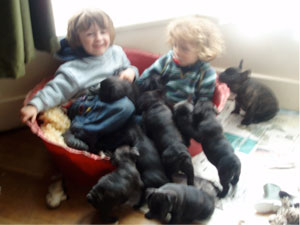
Frenchies love to be around people. Puppies brought up with children make excellent family pets.
What is a French Bulldog like with other dogs?
Frenchies are usually very sociable little dogs. They get on very well with other dogs providing they are introduced to each other carefully. Some breeds take to a Frenchie quite readily whilst others find them too fast and frustrating. Always take your puppy to socialisation classes.
How much exercise does a French Bulldog need?
Frenchies enjoy exercise whether it be running round the garden or walking in the park. They can build up to quite long walks of a couple of miles. However, never over-exercise a young puppy.
The only golden rule is never walk them when it is warm, humid or hot! ALL bull breeds can overheat and die if they become overheated.
What health problems can a French Bulldog have?
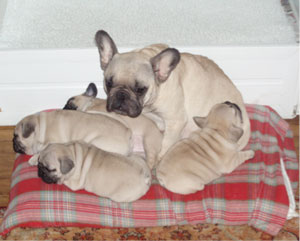
Health problems are not found in all French Bulldogs but some may occur in a dog’s lifetime.
Breathing Problems
A direct result of the flat, rather squashed faces we find so attractive, is the structures behind the nostrils and inside the neck can become rather cramped and affect the dog’s breathing. This problem usually shows itself between 6-12 months.
In some dogs the soft palate at the top of the mouth is too long and can restrict the size of the airway, or can irritate the back of the throat, causing an exaggerated gag response. Any enlargement of the tonsils can also reduce the space needed for breathing.
If the dog becomes hot or excited, the only way it can cool itself down is by panting. Vigorous panting can cause the structures in the throat to swell. The dog frequently brings up large amounts of frothy mucus material, which threatens to choke it.
If the dog shows signs of breathing difficulties, it may need surgery to reduce the overcrowding in the throat.
Back problems
Frenchies have a “roached” back which can sometimes cause spinal problems either by badly formed bony segments of the spine or displacement of the spongy discs between the back bones. This is an issue that the breed is not only trying to improve but irradicate.
If the dog suddenly becomes distressed, perhaps combined with a weakness of one or both back legs, and/or disturbance to the bowel and kidney functions, you must seek veterinary help immediately. Sometimes simply pain relief, anti-inflammatory drugs and total rest is all that is needed. However, sometimes an operation is required. In most cases the dog is able to resume a good quality of life.
Less seriously, and like many dogs, Frenchies can have a problem with their back knee joint. This is called a luxating patella.
Breeders and Breed Club secretaries are always ready to give help and advice on health conditions.
Is there a Breed Health programme or testing?
The French Bulldog Health Scheme is a voluntary testing scheme details of which are available on this site and the French bulldog Club of England web site. However, reputable breeders have always had the health of the puppies in mind when breeding litters.
What size should a French Bulldog be?
The Frenchie is a small to medium sized dog, quite stocky in appearance. When fully grown they are also deceptively heavy.
The male is bigger than the female with a larger head and broader body.
How do I find a reputable breeder?
Newspaper advertisements and the Internet are generally not good places to look. as most reputable breeders don’t tend to advertise their puppies.
A useful contact is the Breed Club secretaries who will happily put you in touch with a reputable breeder.
Not all breeders operate waiting lists. However, when a litter is expected the breeder will give you a date to phone back, or will contact you themselves, to let you know what puppies are available. You may have to be patient and wait for a puppy.
The Kennel Club can also provide advice and run an Assured Breeders Scheme.
(Links to the other two French bulldog Clubs and the Kennel Club are on this site.)
How much should I expect to pay?
There is a great deal of variation in price but don’t believe that the higher the price the better the puppy. For a pet puppy you should, at the moment, expect to pay between £1,000 and £2,000.
Should I get a male or female?
This is really personal preference. A female will have seasons which some owners find a bother. Always talk to the breeder before coming to a final decision.
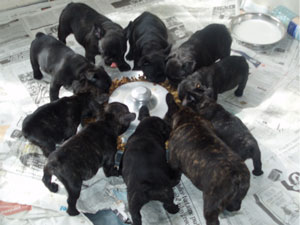
Will I be able to pick any puppy from the litter?
This is unlikely as most breeders will want to keep a puppy themselves. However, discuss your situation with the breeder and they will try to accommodate you. You should always expect to see the mother and, if possible, the father when seeing the litter.
How old should the puppy be?
Puppies do not usually leave their mothers before 8 weeks of age. Some breeders like to keep the puppies until 10 or even 12 weeks of age.
What health checks should have been completed?
The parents of your puppy may have completed one of the Levels of The French Bulldog Health Scheme. The scheme is voluntary so not all French Bulldogs have been tested.
Your puppy should have been checked by a vet prior to leaving the breeder. It is advisable to take it to your own vet within 7 days of purchase for another check.
What help should I get from the breeder?
You should get an advice sheet saying when the puppy has been wormed and when it is due to be wormed again.
The breeder should also give you a diet sheet to explain the feeding regime your puppy is following.
The puppy may also have had the first part or all of its inoculations completed.
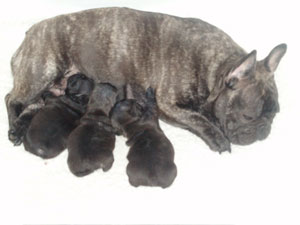
What other paperwork should I get?
You should get a signed pedigree and Kennel Club registration papers. You will need the registration papers to claim your 4 weeks free insurance.
If the puppy has an endorsement on it you should sign a piece of paper to say you are aware of the endorsement and its implications.
You may be asked to sign a contract of care for the puppy and also agreeing not to sell or re home the puppy without first contacting the breeder.
You should get a signed receipt which may offer a full refund if the puppy does not pass your vet’s health check in the first week of ownership.
What is a KC endorsement?
There are 2 endorsements the breeder may choose to put on the puppy.
Progeny not for registration means you cannot breed from the puppy and register the litter with the KC unless the endorsement is lifted by the breeder.
Not eligible for an export pedigree means you cannot sell or export the puppy to another country. This will not, however, stop you getting a Pet Passport for your puppy and taking it abroad on holiday.
Who will give me advise when I get the puppy home.
Your first point of contact should be the breeder. After that you can phone the breed secretaries for advice. Don’t expect your vet to know more than the breeder about the breed. Some may never have come across a French Bulldog before.
How do I find a good vet?
When you bring your puppy home you will need to find a veterinary practice which is used to dealing with flat faced breeds. Breed Club Secretaries may be able to tell you of such vets in your area.
If there are none within a convenient distance, try to find somebody with a Bulldog, Pug or Boston Terrier and ask for their recommendations. Again, the Breed Club secretaries of these breeds may be able to help.
What exactly are the colours of the French Bulldog?
As it says in the Breed Standard, there are three recognised colours:
Brindle
Brindle is a mix of dark and coloured hairs. Brindle Frenchies can range from “dark brindle” which looks almost black to “tiger brindle” where the mixture of black and coloured hairs take a “stripey” appearance.
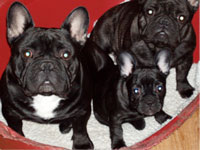
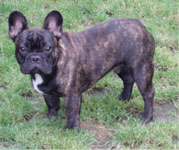
Dark Brindles Tiger Brindles
Fawn
Fawns have the overall colour of warm sand but can vary from very pale to dark gold.

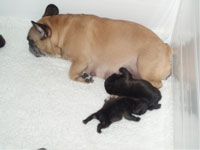
Pale Fawn Dark Gold
Ideally the face should be covered with very dark hairs giving it a typical dark mask.
Pied
Pieds are predominately white with some brindle patches, although some are completely white. Their markings can vary greatly especially on their heads.

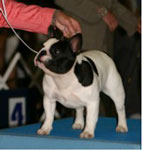
Half Hooded Pied Hooded Pied
Some pieds are prone to “Ticking”, which is a small cluster of dark hair growing through the white areas of the coat giving it a spotted appearance.
BLUE, TAN AND BLACK AND TAN ARE NOT RECOGNISED COLOURS .